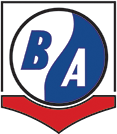Premature masonry carbide tipped drill bit failure is usually the result of misuse or
errors by the operator. Sometimes, job-site conditions such as embedded
reinforcing bars will contribute to failure as well. Here are a few
rules to follow that will make your bit last as long as possible:
-
Do not come in contact with embedded rebar when using a carbide
tipped drill bits used for hammer drilling. When embedded rebar is
encountered, if possible, relocate the hole to be drilled. If the hole
being drilled cannot be relocated, use a rotary-only drill motor and
the B&A
Rotary Rebar
Cutter carbide tipped drill bits to cut through the embedded rebar.
-
After the hole has been started do not attempt to realign an
off-center hole by exerting undue side pressure on the carbide tipped drill bits. This
may cause the bit to break.
-
If the carbide tipped drill bits arenít cutting as fast as when new,
this is a good
indication that carbide-tip is dull. Have carbide tipped drill bits re-sharpened by a
qualified sharpening service or send it to
B&A for a factory
sharpening. Worn or dull carbide tipped bits will reduce bit life and could fail.
-
When using carbide tipped drill bits and heat starts to build up,
never pour water into the hole. Some carbide tipped drill bits can be used
with water, but only when water is introduced in the beginning of the
hole-drilling process. (Contact B&A for further details.)
-
Always apply adequate pressure to keep carbide tipped drill bits engaged in the
power tool and to insure the carbide tip is cutting and not merely
rubbing the concrete. Be careful not to overload the drill or hammer
motor.
-
Do not drill any deeper than the length of the flutes manufactured
into the bit. Drilling beyond the fluted portion of the carbide tipped
drill bits causes
debris to clog in fluting and the hole and can cause premature wear and
even bit failure.
-
Withdrawing the carbide tipped drill bits from the hole on a regular basis helps to clean dust and debris from the hole and
flute,
therefore lessen the chance of the carbide tipped drill bits from binding. Excessive force such as
encountered with a pipe-wrench in an attempt to remove a bound-up
carbide tipped drill bits
from drilled holes can result in bit failure.
-
Always keep the shank portion of the carbide tipped drill bits clean. When using a
hammer bit, always insure the shank of the carbide tipped drill bits are being lubricated in
the hammers nosepiece.
-
Carbide tipped drill bits should be kept in a suitable containers to
help prevent damage if the bit is dropped or mishandled.
-
Inspect all drill chucks and hammer nose pieces for wear before
inserting a bit. A worn chuck or nosepiece can cause damage.
